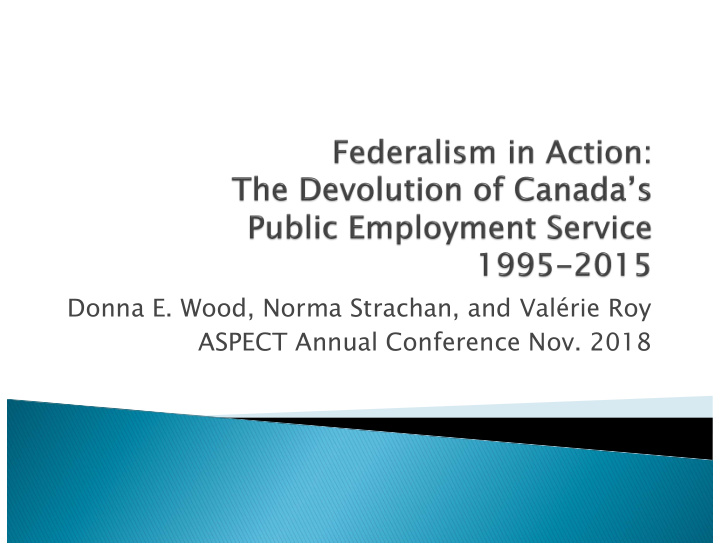



Donna E. Wood, Norma Strachan, and Valérie Roy ASPECT Annual Conference Nov. 2018
} What is the Public Employment Service or PES? } A Pan-Canadian Look at the PES in 2015 } Key Questions Explored in the Book } Criteria to Compare Provincial Governance Choices & Outcomes } The Alberta-BC Comparison } The Ontario-Québec Comparison } How do the Devolved Services Compare to Federal Delivery? } How is the Government of Canada Managing its Role Post-devolution? } How Does Canada’s PES Work Together as a Whole? } More Information 2
} All developed countries have a PES } The role of a PES (ILO convention 88) is to: 1. Assist workers to find suitable employment and assist employers in finding suitable workers 2. Facilitate occupational and geographic mobility 3. Collect and analyze information on the employment market 4. Cooperate in the administration of unemployment insurance and other income support programs 5. Assist other bodies to ensure a favourable employment situation 3
4
} Here are the questions the book tried to answer: What governance choices did each province 1. make? What outcomes have been achieved? How do the devolved PES services compare 2. to when they were delivered by Ottawa? How is the Government of Canada 3. managing its role post-devolution? How does Canada’s PES work together as a 4. whole? 5
} Criteria to assess governance: } - Decentralization } - Single gateways or one-stop shops } - Outsourcing and contracting out } - Partnerships and networks } Criteria to assess performance: } - Effectiveness } - Efficiency } - Democracy 6
} British Columbia } Alberta } Multiple gateways, } One-stop shops uncoordinated } Centralized decisions } Decentralized decisions } Extensively contracted } Mixed government/contracted services } Formalized relationship with WorkBC contractors, } Informal partnerships otherwise informal with industry/ASETS relationships 7
} 57 Alberta Works Centres managed by government provide single point of access to all work, welfare and workforce development services } 72 WorkBC Employment Service Centres plus 100 Social Development Offices plus JTST contractors plus Service Canada } Contracting decisions in AB made in regions, in BC centralized decision-making through BC Bid 8
} Alberta: } 5 industry contributor groups } Training Provider Advisory Committee } Strong regional partnerships with ASETS } No legislation so changes at political whim } British Columbia: } 10 sector advisory groups, 8 regional workforce tables } More formalized relationship with WorkBC contractors } Weak partnerships with ASETS holders } No legislation so changes by political whim } ASPECT important connector in the sector 9
Figure 5 Outsourcing NL NB MB SK AB QC PE NS ON BC Outsourced Government Delivery Run 10
} Alberta’s PES programs were more effective than British Columbia’s (more people served, more short term interventions) } Alberta’s PES programs were more efficient (lower cost, more EI savings, better coordination ASETS, longer time delivering, better staff training) } BC’s programs were more democratic (better reporting, public evaluations, more public engagement of workforce tables) 11
} Ontario } Quebec } Multiple access points } One-stop shops } Mix of } Decentralized centralized/decentralized } Mix of } Extensively contracted government/contracted services } Strong institutionalized } Limited central formal partnerships partnerships. 26 local Workforce Planning Boards 12
} Ontario } Employment Ontario is front door of PES } Network of 170 contracted service providers (no wrong-door access) } Parallel doors through 47 municipal entry points, 101 First Nations Bands and 150 MCSS service providers } Quebec } 158 Local Employment Centres (one-stop shop) are front door of Quebec’s PES } Supported by a dense network of 350 contracted service providers 13
} Ontario } 26 Local Workforce Planning Boards } Ontario Training & Adjustment Board closed in 1996 } No institutionalized connections with ASETS holders } Quebec } Commission des partenaires du marche du travail } National Forum managed relationship between EQ and contracted service providers } Formal coordination with ASETS holders 14
Figure 5 Outsourcing NL NB MB SK AB QC PE NS ON BC Outsourced Government Delivery Run 15
} Effectiveness: Quebec’s approach was more effective than Ontario’s ◦ (investment in research and innovation, returns to work, evaluation and monitoring systems) } Efficiency: Quebec’s programming is slightly more efficient than Ontario’s ◦ (cost per client, return on investment, systems in place) } Democracy: Quebec’s system was more democratic than Ontario’s ◦ (information available, accountability tools, partnership arrangements) 16
} More than 3X as many clients served 2013/14 vs 1995/96. - Significant shift from EI attached or Reachback to Non insured - Shift from long term interventions to light touch (Work First) - Decline in cost per client from $7,359 to $2,794 (1995 to 2013) - CRF funded programming for “designated groups” had dropped by more than half between 1993/94 and 1994/96 due to “federal fiscal restraint”. - Final numbers: - Post devolution, 1,168,227 Canadians used PES services in 2013/14, compared with 367,472 in 1995/96 - Devolution HAS improved PES outcomes! } - Evaluations have also demonstrated effectiveness of provincial programming 17
} With difficulty in a highly complex and fragmented system } Inconsistent direction, eg. Conservative threat to LMA funds (2013), inconsistent decision-making re immigrant programming, no movement on transfer of youth programming } Issues with federal-provincial and federal- Aboriginal accountability arrangements } Stakeholder involvement and investment in research are lacking } However: } Liberals delivered new Workforce Development Agreements 18
} Not particularly well, better than before. } P/T services, Indigenous services, federal services all live in different worlds with no institutions to connect them. } Government of Canada has retained authority and controls the money. } FLMM is working better than before but subject to vagaries of politics. } No institutional structures to hear voices of others: all handled informally. } We could do better. 19
} Federalism in Action available for purchase through U of T Press } Donna Wood woodd@uvic.ca } Norma Strachan anstrachan@shaw.ca } Valérie Roy vroy@axtra.ca } Follow Donna Wood’s blog at https://donnaewood.wordpress.com/ 20
Recommend
More recommend